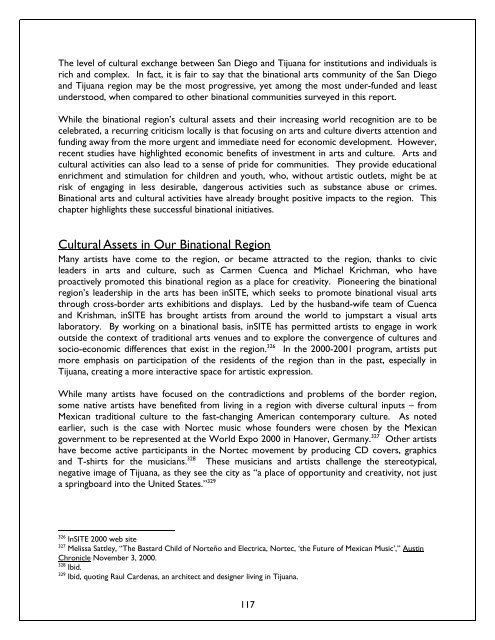Blurred Borders - International Community Foundation
Blurred Borders - International Community Foundation
Blurred Borders - International Community Foundation
You also want an ePaper? Increase the reach of your titles
YUMPU automatically turns print PDFs into web optimized ePapers that Google loves.
The level of cultural exchange between San Diego and Tijuana for institutions and individuals is<br />
rich and complex. In fact, it is fair to say that the binational arts community of the San Diego<br />
and Tijuana region may be the most progressive, yet among the most under-funded and least<br />
understood, when compared to other binational communities surveyed in this report.<br />
While the binational region’s cultural assets and their increasing world recognition are to be<br />
celebrated, a recurring criticism locally is that focusing on arts and culture diverts attention and<br />
funding away from the more urgent and immediate need for economic development. However,<br />
recent studies have highlighted economic benefits of investment in arts and culture. Arts and<br />
cultural activities can also lead to a sense of pride for communities. They provide educational<br />
enrichment and stimulation for children and youth, who, without artistic outlets, might be at<br />
risk of engaging in less desirable, dangerous activities such as substance abuse or crimes.<br />
Binational arts and cultural activities have already brought positive impacts to the region. This<br />
chapter highlights these successful binational initiatives.<br />
Cultural Assets in Our Binational Region<br />
Many artists have come to the region, or became attracted to the region, thanks to civic<br />
leaders in arts and culture, such as Carmen Cuenca and Michael Krichman, who have<br />
proactively promoted this binational region as a place for creativity. Pioneering the binational<br />
region’s leadership in the arts has been inSITE, which seeks to promote binational visual arts<br />
through cross-border arts exhibitions and displays. Led by the husband-wife team of Cuenca<br />
and Krishman, inSITE has brought artists from around the world to jumpstart a visual arts<br />
laboratory. By working on a binational basis, inSITE has permitted artists to engage in work<br />
outside the context of traditional arts venues and to explore the convergence of cultures and<br />
socio-economic differences that exist in the region. 326 In the 2000-2001 program, artists put<br />
more emphasis on participation of the residents of the region than in the past, especially in<br />
Tijuana, creating a more interactive space for artistic expression.<br />
While many artists have focused on the contradictions and problems of the border region,<br />
some native artists have benefited from living in a region with diverse cultural inputs – from<br />
Mexican traditional culture to the fast-changing American contemporary culture. As noted<br />
earlier, such is the case with Nortec music whose founders were chosen by the Mexican<br />
government to be represented at the World Expo 2000 in Hanover, Germany. 327 Other artists<br />
have become active participants in the Nortec movement by producing CD covers, graphics<br />
and T-shirts for the musicians. 328 These musicians and artists challenge the stereotypical,<br />
negative image of Tijuana, as they see the city as “a place of opportunity and creativity, not just<br />
a springboard into the United States.” 329<br />
326<br />
InSITE 2000 web site<br />
327<br />
Melissa Sattley, “The Bastard Child of Norteño and Electrica, Nortec, ‘the Future of Mexican Music’,” Austin<br />
Chronicle November 3, 2000.<br />
328<br />
Ibid.<br />
329<br />
Ibid, quoting Raul Cardenas, an architect and designer living in Tijuana.<br />
117















